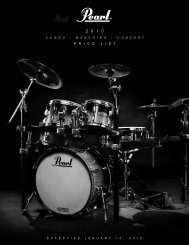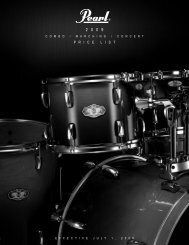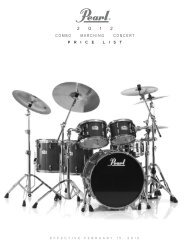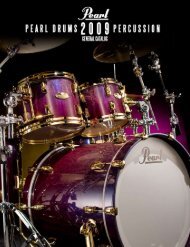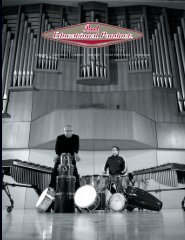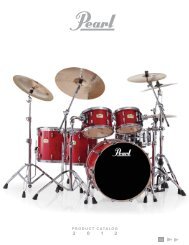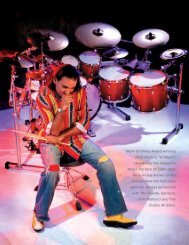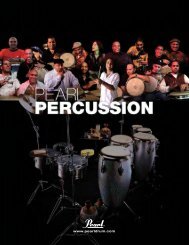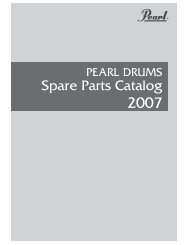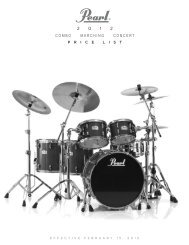Timpani Tuning
Timpani Tuning
Timpani Tuning
You also want an ePaper? Increase the reach of your titles
YUMPU automatically turns print PDFs into web optimized ePapers that Google loves.
<strong>Timpani</strong> <strong>Tuning</strong>by J.B. SmithSeveral issues must be addressed in order for a young percussionist to develop the skillsneeded to play the timpani: technical facility, tone production, instrument care andtuning. Of these, tuning is often the most difficult to learn. Ear-training should beregular part of a percussionist's study.A basic course of study can progress as follows:• Learn to match pitches. Using a pitch pipe, piano or keyboard percussion instrument,sing pitches after they are played.• Learn intervals so that pitches can be derived from a reference tone (i.e., tuning fork).Begin by associating intervals with familiar melodies (like the perfect fourth that opens"Here Comes the Bride").• Learn to "sing" counts during rests to make pitch changes. By combining pitch singingwith rest counting players can be assured that they will both tune accurately and play intime.As an example, during a two bar rest, a C on a 26" drum must be changed to a D. Singthe counts in the silent measures on the pitches that will be heard on the drums. In thefirst measure sing the counts "1-2-3" on the pitch C, on count "4" glissando from C to Dwhile flicking the head with a finger or lightly tapping on the head with a mallet. In thesecond measure sing the four counts on the D pitch. By singing the glissando, the voicematches the sound of the timpani as the tension of the head increases. This allows theears to better hear the change so that the feet can "put on the brakes" at the correct point.Musical example 1 is a short exercise which requires that a pitch change be made.During measures 3 and 4 the top drum is raised from C to D. In measures 7 and 8 thedrum is returned to its original pitch. In example 2 the same part is shown with the sungcounts written into the part. A good method book that can be used for this purpose is theFriese-Lepak <strong>Timpani</strong> Method. Starting on page 51 there are numerous short exerciseswhich require pitch changes. Singing parts added in the rests insure that the pitchchanges and rest lengths are accurate.
<strong>Tuning</strong> gauges have helped to alleviate some of the tuning problems experienced bytimpanists, especially those of young players. More advanced players, however, mustbecome fluent with tuning principals and interval relationships. Just as a trumpet playerlearns to adjust a slide in performance to accommodate tuning adjustments, so must thetimpanist be able to match the pitches of an accompanist or the other members of anensemble.
Dr. J. B. SmithDr. J. B. Smith is presently Associate Professor of Music and the Coordinator ofPercussion Studies at Arizona State University. He is director of the ASU PercussionEnsemble, which toured Russia and Poland in 1990 and performed at the Percussive ArtsSociety International Convention in Anaheim in 1991. The group recently commissionedand premiered Anthony Braxton's Composition No. 174 for Percussion Ensemble andConstructed Environment and Mary Ellen Childs' Crash. Dr. Smith also directs thePandevils Steel Drum Band. He served as principal percussionist with Ensemble 21, acontemporary music group under the direction of Arthur Weisberg, as principalpercussionist with The Daniel Lentz Group which recently performed at the InterlinkFestival in Los Angeles and the Bang on a Can Festival in New York, and is the musicliaison for ASU's Institute for Studies in the Arts.He received his Bachelor of Music Education degree from Baylor University where hestudied with Dr. Larry Vanlandingham, his Master of Music in Percussion Performanceand Literature degree from the university of Illinois where he studied with Prof. TomSiwe and his Doctoral of Musical Arts degree from the University of North Texas wherehe studied with Dr. Robert Schietroma. Previously, Dr. Smith was on the music facultiesof Tarleton State University in Stephanville, Texas and Humboldt State University inArcata, California. He has written articles for The Instrumentalist, and Percussive Notesand served as president of the Arizona chapter of the Percussive Arts Society.Dr. Smith is also active as a composer, with numerous works published by Whole>SumProductions Press, and is a veteran of many interdisciplinary productions, such asReversing the Spell with composer Robert Kaplan and John Mitchell, The Nose byElizabeth Egloff, and The Binary Wheel with light sculptor Milton Komizar, in which heparticipated in various capacities as musician, photographer, airbrush artist and slideprojection designer.



